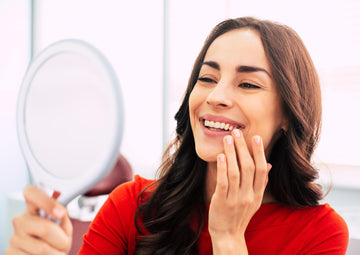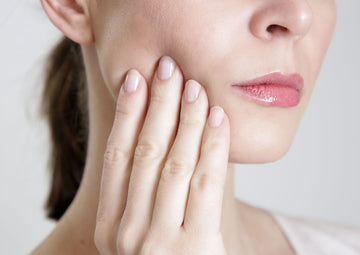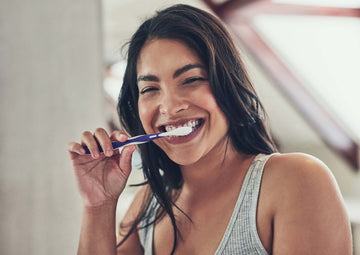

Smiling is a universal language that can be shared between people all over the world. But a smile can be used to communicate much more than happiness.
You might be surprised to learn that there are over a dozen different types of smiles that people use in a regular rotation and they all have different meanings — whether we’re consciously aware of it or not. People smile when they’re embarrassed, angry, flirting, and even frightened.
As we continue to navigate within a remote-first world, body language may not be conveyed as easily as before and facial expressions are relied on more than ever to tip us off to someone’s feelings and intentions.
Read on for 12 common types of smiles that will help you understand these nonverbal cues and better communicate within your relationships and in your workplace — or jump straight to the infographic.
- Duchenne smile
- Dampened smile
- Forced smile
- Qualifier smile
- Sneer
- Embarrassed smile
- Contempt smile
- Polite smile
- Wistful smile
- Flirtatious smile
- Pan Am smile
- Open-mouth smile
1. Duchenne Smile
Coined by the French neurologist Guillaume Duchenne de Boulogne, this type of smile is an easy one to spot. This is a genuine smile that you give when you reunite with a loved one or come home to your furry best friend after a long day at work.
These smiles are easily recognized because they engage two distinctive facial muscles — the zygomatic muscle around the cheeks that’s responsible for turning the corners of our lips upward, and the orbicularis oculi muscle that contracts around our eyes creating crow’s feet.
A 2013 study discovered that pairs of strangers getting to know one another tended to match the smile of the other person whether it was polite or genuine. Additionally, a person responded with a genuine smile much faster than a polite one. The study determined that different smiles have varying levels of social reward, with a genuine smile being the most valuable.

2. Dampened Smile
A dampened smile is one that a person would use when they’re trying to conceal the intensity of the positive emotion that led them to smile. Someone giving a dampened smile will raise their cheeks, but try to pull the corners of their mouth downward.
This type of smile is interesting because it reflects cultural norms and how different areas of the world vary in how they share smiles. For example, in a country like Japan where displays of emotion are discouraged, people smile with their eyes rather than their lips.
3. Forced Smile
A forced smile is one you’d use in an uncomfortable situation where you’re trying to show positive intent. Also great for diffusing situations, a forced smile might be over-exaggerated and last longer than a natural smile because it’s meant to be noticed.
4. Qualifier Smile
A qualifier smile is used when expressing negative or disappointing news to another person. According to psychologist Paul Ekman, the qualifier smile is usually accompanied by a head nod and a slight down and sideways tilt of the head. The qualifier smile serves as a way to deliver bad news with a little less sting. Depending on the situation, this can often be a misleading nonverbal cue for the person on the receiving end.
5. Sneer
Sneers fit perfectly into the dominance category of smiles that are used to exert influence and power over another. This mocking and sarcastic smile exudes disdain for another. Sneers are typically lopsided where one side of the mouth will be upturned while the other remains down.
This type of smile does intimidate others — research has shown that people on the receiving end of a dominant smile tended to have higher levels of the stress hormone cortisol in their saliva for up to 30 minutes after the encounter.
6. Embarrassed Smile
We’ve probably all been guilty of employing this type of smile. A popular study from 1995 characterizes embarrassed smiles with a tell-tale downward tilt of the head and eyes shifting to the left. These smiles typically don’t last very long.
7. Contempt Smile
Oddly enough, the contempt smile shares characteristics with the Duchenne smile. They both include open-mouthed smiles with upturned corners of the mouth, but the contempt smile will include a tightening of the corners of the lips.
This smile is common in parts of the world where it’s not socially acceptable to show anger. “Where I’m from in Indonesia, anger is usually not considered socially acceptable,” said Zara Ambadar, a cognitive psychologist at the University of Pittsburgh. “Instead people tend to smile a lot when they’re angry.”

8. Polite Smile
Polite smiles are very common. This is the type of smile you use when you’re first meeting someone or you’re trying to convey interest in a long-winded story. Polite smiles are often employed in the workplace because they give the sense of friendliness without the emotional intimacy of a genuine Duchenne smile.
Interestingly, even babies switch between genuine and polite or false smiles. “At just 10 months, for instance, an infant will offer a false smile to an approaching stranger while reserving a genuine…smile for its mother,” behavioral science writer Eric Jaffe wrote in an article for the Association for Psychological Science.
9. Wistful Smile
A wistful smile is used when feeling a conflicting mix of happiness and sadness. This is the type of smile you’d have when reflecting on the loss of a loved one and the memories you shared. While it might be odd to think of smiling during emotional moments, the ability to smile as you grieve is thought to help protect you as you recover, according to experts at the National Institutes of Health.
10. Flirtatious Smile
Often referred to as the Mona Lisa smile, the flirtatious smile can be employed in a number of ways depending on the personality or style of the person doing the flirting. Coy flirters might smile while tipping their head down slightly, while a subtle flirt might keep their lips together and lift an eyebrow. A study conducted by the University of Kansas found that women tend to exhibit similar flirtation cues including a head tilt, direct eye contact, and a slight smile.
11. Pan Am Smile
The Pan Am smile is named after the iconic Pan Am flight attendants because they were trained to smile at each and every passenger. Think of this type of smile as a fake customer service smile. But be careful with how often you use a Pan Am smile, especially if you work in the service industry. A study testing the authenticity of smiles found that genuine smiles have a positive impact on a customer’s willingness to tip.

12. Open-Mouth Smile
The open-mouth smile is often used by celebrities to invoke a sense of closeness with others. This smile conveys a care-free and happy attitude and mimics the facial expression of a person laughing. According to psychologist Paul Ekman, this type of smile can often include two emotions: enjoyable-surprise or enjoyable-excitement. Ekman says the enjoyable-surprise can be spotted by a raised brow, dropped jaw and a raised upper eyelid.
Bottom Line: A Smile Says it All
There’s no denying the power a smile can have in communicating a wide range of emotions. While genuine smiles do the best at building relationships and establishing positive intent, the other smile types serve distinct purposes as well.
Knowing the tell-tale signs of different types of smiles will not only help you in your relationships (both romantic and platonic), but they will also serve you well as you navigate situations in the workplace. As the saying goes, actions speak louder than words, and we’d argue that a smile says quite a bit.





